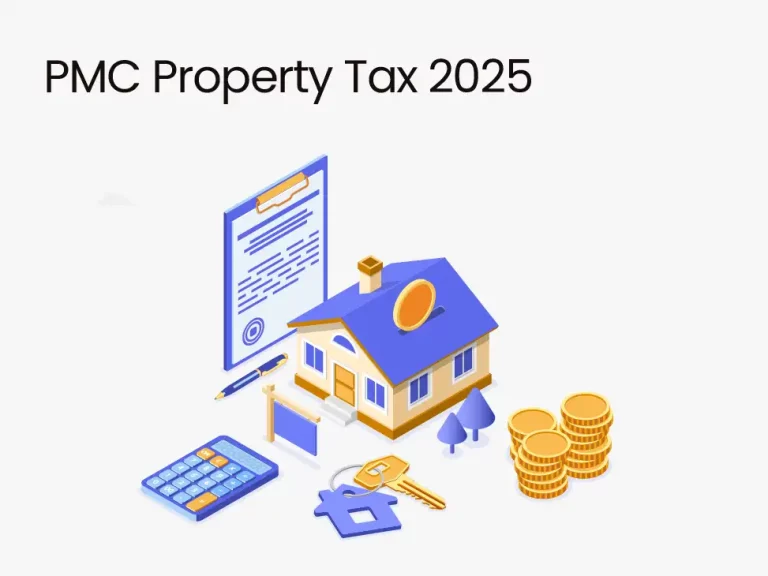Rashi Sood
Last Updated on 24th July 2025

Rashi Sood
Last Updated on 24th July 2025
Property tax plays a vital role in funding Pune’s infrastructure, public services, and urban development. In 2025, the Pune Municipal Corporation (PMC) continues to modernize its approach, introducing updates and reforms to make the system more transparent, efficient, and user-friendly for taxpayers. Whether you’re a homeowner, investor, or new resident, this comprehensive blog covers everything you need to know—how property tax is calculated, available rebates, online payment methods, penalties for late payments, and more.
Table of Contents
The PMC property tax is a civic levy collected annually on residential, commercial, industrial, and vacant land within Pune city limits. Managed by the Taxation & Tax Collection Department of the Pune Municipal Corporation, it generates revenue for essential services such as roads, water, sanitation, municipal staff, parks, lighting, drainage, and governance.
PMC holds jurisdiction over more than 14 lakh properties. Since the latest revenues depend on timely tax collection, the corporation actively encourages on-time payments through rebates and simplified online tools.
PMC maintains a graded per-square-foot rate depending on:
While a simple formula is:
Property Tax = Capital Value x Tax Rate
To calculate capital value:
Capital Value = Base Area x Built‑up area × Zone rate × Age × Usage factor
You can also use the PMC’s online Tax Calculator to help you estimate your dues accurately.
Under Maharashtra law, the PMC property tax 2025 offers a 40% rebate on self-occupied homes. To qualify:
This rebate was reinstated in 2024 after being discontinued in 2019.
To incentivize prompt payment:
Thus, a timely payer of a qualified self-occupied property might enjoy ~40% + ~10% ≈ 50% total deduction.
PMC’s official portal is the easiest way to view dues and complete payments:
Step 1: Visit the PMC property tax portal and go to “Prop Dues Details.”
Step 2: Enter the Property type (O/P/F) and Section ID, Peth ID, and Account number.
Step 3: Generate your due amount.
Step 4: Pay using UPI, wallets, net banking, credit/debit cards, EMI, IMPS, or cash.
Step 5: Download the receipt immediately.
Step 6: For the rebate, the PT-3 form and documents may need to be submitted at the ward office.
PMC does not provide a direct “search by name” lookup. Instead, you’ll need:
Once you enter these details on the portal, you can view and fetch your property bill.
Late payment incurs:
To avoid penalties, always pay on time or proactively contact PMC if delays occur.
Paying your PMC property tax isn’t just mandatory—it’s a civic duty that contributes to Pune’s growth and well-being. FY 2025–26 offers valuable incentives like a 40% rebate for self-occupied homes and an added early payment discount. By staying informed and paying on time, you not only reduce your costs but also support Pune’s development—be it better roads, drainage, parks, or smart-city amenities.
Any person or entity that owns property—whether residential, commercial, industrial, or vacant land – within the geographical limits of the Pune Municipal Corporation (PMC) is obligated to pay property tax. This applies to all properties irrespective of whether they are self-occupied, let out, or vacant.
There’s no official indication of a rate increase for FY 2025–26. PMC continues using its capital-value system with updated base values, usage, age, and floor factors.
First half-year payment (April–September): The original discount deadline was May 31, 2025; this was extended to June 30, and further to July 7, 2025 due to delayed billing and technical issues. Payment by this date earns a 5–10% early-bird rebate.
Second half-year payment (October–March): Due December 31, 2025, with no early-bird rebate beyond the annual discount.
PMC uses the following formula:
Property Tax = Capital Value × Tax Rate
Where:
Capital Value = Base value × Built-up area × Use category × Building type × Age factor × Floor factor
The 40% self-occupancy rebate on property tax, reinstated in August 2024 by the Maharashtra legislature, applies to self-occupied residential properties—not rented or vacant. Once approved, it remains valid unless the property is rented out.
Owners of properties registered on or after April 1, 2019, must submit a PT-3 form, a fee, and documents like a voter ID, NOC from the housing society, or utility bills at their ward office or citizen facilitation centre. Properties registered before that date don’t need to reapply.
If property tax isn’t paid on time, a 2% monthly penalty applies—after July 7, 2025, for the first half, and after January 1, 2026, for the second. Rates may vary from 5–20% annually.